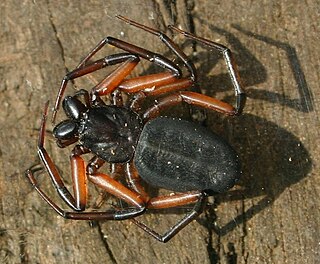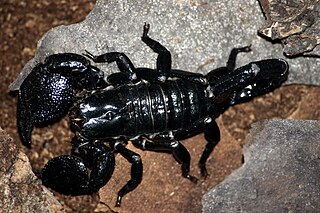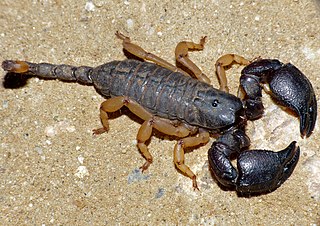
Scorpions are predatory arachnids of the order Scorpiones. They have eight legs, and are easily recognized by a pair of grasping pincers and a narrow, segmented tail, often carried in a characteristic forward curve over the back and always ending with a stinger. The evolutionary history of scorpions goes back 435 million years. They mainly live in deserts but have adapted to a wide range of environmental conditions, and can be found on all continents except Antarctica. There are over 2,500 described species, with 22 extant (living) families recognized to date. Their taxonomy is being revised to account for 21st-century genomic studies.

Thelyphonida is an arachnid order comprising invertebrates commonly known as whip scorpions or vinegaroons. They are often called uropygids in the scientific community based on an alternative name for the order, Uropygi. The name "whip scorpion" refers to their resemblance to true scorpions and possession of a whiplike tail, and "vinegaroon" refers to their ability when attacked to discharge an offensive, vinegar-smelling liquid, which contains acetic acid.

Opisthacanthus rugiceps is a species of African scorpion.

Paravaejovis spinigerus, commonly known as the stripe-tailed scorpion or the "devil" scorpion, is very common and widely distributed in Arizona and southwestern New Mexico. This species is one of larger members of the genus Paravaejovis, which also includes Paravaejovis confusus.
Hadogenes bicolor is a species of scorpion endemic to South Africa.

The Buthidae are the largest family of scorpions, containing about 96 genera and over 1230 species as of 2021. Its members are known as, for example, fat-tailed scorpions and bark scorpions. A few very large genera are known, but a high number of species-poor or monotypic ones also exist. New taxa are being described at a rate of several new species per year. They occur in the warmer parts of every major landmass on Earth, except Antarctica and New Zealand. Together with four other families, the Buthidae make up the superfamily Buthoidea. The family was established by Carl Ludwig Koch in 1837.

Platyoides is a genus of spiders belonging to the family Trochanteriidae. Its members are known as scorpion spiders and are found in sub-Saharan Africa and its islands, Madagascar, Réunion, Aldabra and the Canary Islands.

Hadogenes troglodytes is a species of scorpion from southern Africa. It is commonly known as the flat rock scorpion and commonly sold on the exotic pet market. It was once regarded as having the longest recorded body length of any scorpion, reaching up to 20 cm; however Heterometrus swammerdami currently holds the record for being the world's largest scorpion at 9 inches (23 cm) in length.

Pandinus is a genus of large scorpions belonging to the family Scorpionidae. It contains one of the most popular pet scorpions, the emperor scorpion . The genus is distributed widely across tropical Africa and the southeastern Arabian Peninsula.

Uroplectes is a genus of scorpions in the family Buthidae. They are known commonly as the lesser thick-tailed scorpions. There are about 40 species distributed in the Afrotropical realm. They are most diverse in South Africa.

Parabuthus is a genus of large and highly venomous Afrotropical scorpions, that show a preference for areas of low rainfall. Their stings are medically important and human fatalities have been recorded.
Parabuthus brevimanus is a species of scorpion from southern Africa, that ranges from southern Angola to Namibia and western South Africa, where its range extends south of the Orange River.
Chaerilus is a genus of scorpions, the only genus in the monotypic family Chaerilidae. They live in tropical parts of South Asia and Southeast Asia. A fossil genus Electrochaerilus is known from the Late Cretaceous (Cenomanian) aged Burmese amber.
Tityus tenuicauda is a species of scorpions in the family Buthidae. This species is endemic to the island of Trinidad in Trinidad and Tobago.

The Scorpionidae make up the superfamily Scorpionoidea. The family was established by Pierre André Latreille, 1802.

Hadogenes is a genus of large African scorpions found from South Africa up to Tanzania.

Hadogenes gracilis is a species of scorpion in the family Hormuridae. The distribution of this species is restricted to the Magaliesberg and surrounding rocky outcrops in South Africa, which are threatened by mining.

Opisthacanthus africanus is a species of African scorpion.

Hormuridae is a family of scorpions in the order Scorpiones. There are about 10 genera and more than 90 described species in Hormuridae.














